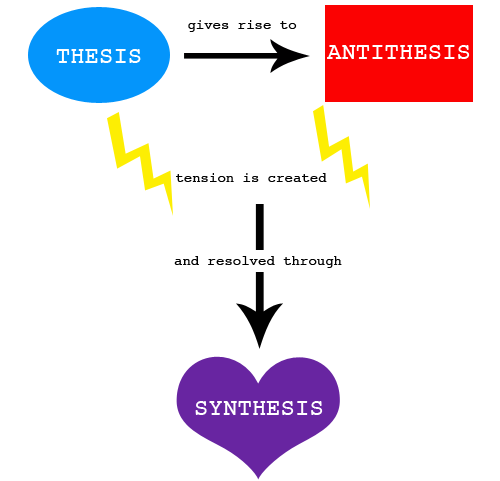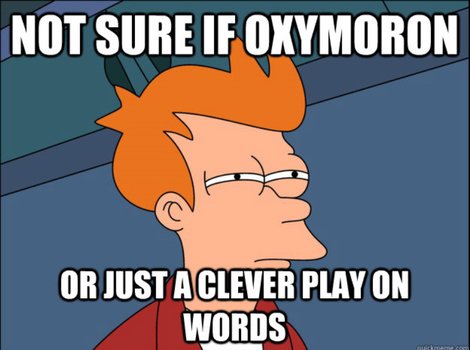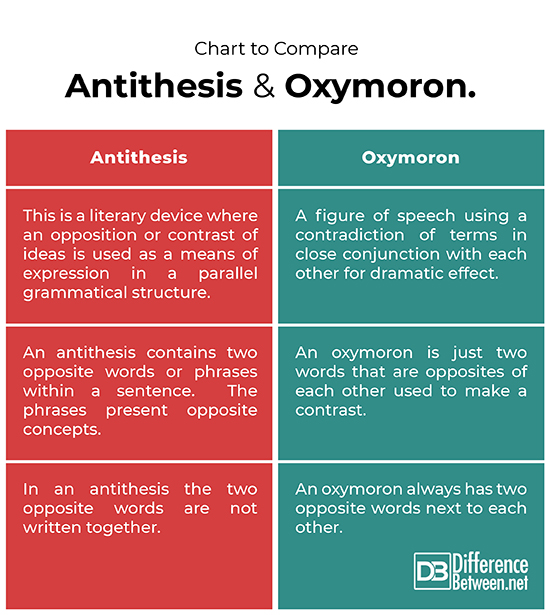Difference Between Antithesis and Oxymoron
Antithesis and oxymoron are literary devices that create interesting contrasts and are useful for bringing home a point the writer wishes to make. Although they have the same purpose in mind, they are used differently in terms of sentence structure and presentation. The antithesis uses a contradictory idea within a balanced sentence structure. An oxymoron uses two contrasting words, but they appear in the sentence within the same phrase one after the other. The difference therefore is more in the grammatical presentation rather than the concept of using two opposite words to bring home a point in a narrative. The effect of both these literary devices is to highlight a point or bring a characters personality to the fore. The use of antithesis helps create this emphasis with contrasting or opposite words to describe the person place or thing.

Definition and use of Antithesis
The word antithesis has its origin in the Greek word antithenal which means to oppose. The plural of antithesis is antitheses. The antithesis shows up best in a structured sentence used with a form of parallelism where the contrasting words appear in each of the structured phrases in the sentence. The contrast falling into one structured sentence adds more power to the statement the writer is making and makes it more memorable.
“We must learn to live together as brothers or perish together as fools.”
These famous words, spoken by Martin Luther King Jnr. have a far greater impact because of the antithesis between the two parts of the sentence, separated by the word or.
The antithesis helps the writer to persuade their readers through emotional responses that there is a worthy message in the book. Politicians, writers and poets all use antithesis to stir emotional reactions from their readers or listeners. Antithesis is a persuasive form of rhetoric and is used to provoke an emotional response to all forms of writing.

Definition and use of Oxymoron
The oxymoron makes use of a paradox. Two contradictory words are used in the same phrase to create a contrast of ideas. The two words may seem absurd together, but they have the ability to add value to the description by highlighting the depth of meaning. Thisis achieved by using the two opposite words together. There are many examples of an oxymoron and some of them have become part and parcel of common expressions. The oxymoron has found its way into poetry, musical lyrics, classical literature, and even modern technology. Sounds of silence and virtual reality as well as speaking in a loud whisper are all great examples of the oxymoron.
The word oxymoron comes from the Greek word oxymoron. When this word is broken into two parts there is Oxus meaning sharp and moros interpreted as dull. The origin of the word is an oxymoron. A sharp dull word is the translation of the word. A person cannot be an oxymoron because the word does not refer to a moronic person. Oxymoronically is the adverbal form of the root word oxymoron. Oxymoronic is the adjectival form of the word. There is no verb form of the word that can be used. Shakespeare used the oxymoron to its full potential in his plays. In particular, the love lost between Romeo and Juliet, is described with meaning through a series of oxymorons.
“Why then, O brawling love, O loving hate
O anything from nothing first create
O heavy lightness! Serious vanity!
Misshapen chaos of well seeming form
Feather of lead, bright smoke, cold fire, sick health.”
Feather of lead contrasts the light headed feeling of being in love with the heaviness of love lost and sick health the gravity of feeling love sick. It highlights the sadness that comes as the result of love that is not returned by the person one may be in love with.
Every line is dramatically brought to life with a multitude of oxymorons.
Why writers make use of Antithesis?
Consider these points for the value of antithesis in writing.
- The writer can create contrasts of character and place emphasis on different personalities. The antithesis accentuates personal qualities and dramatises different environments.
- The antithesis highlights the magnitude or range of an incident. Two different times of the day for example are shown in opposition to contrast their effect. The brightest day and the darkest night are examples of this contrasting antithesis.
- Writers express strong emotions through the antithesis. The antithesis allows the writer to accentuate strong concepts by setting them in opposition to one another.
- Using one characteristic and setting it off in complete opposition to another creates an understanding of the personalities and the part they play in the plot. The fairy tale characters of Snow White and the wicked queen are examples of the antithesis between these two key personalities in the story. Snow White young and pure and unblemished with her name as white as snow is a strong reference to the innocence the wicked queen does not possess.
- Contrasts in time and historical evidences help create the backdrop for a dramatic story and Charles Dickens used antithesis to show how the French Revolution created exactly those kinds of opposites to be known as ‘the best of times and the worst of times’ as he uses the French Revolution as the backdrop of his novel ‘A Tale of Two Cities.’
Creative uses for an oxymoron
The oxymoron stands out as a creative writing tool used in different genres of literary work.
- Poetry is filled with oxymorons. John Milton used an oxymoron to describe hell as ‘visible darkness’ in book one of Paradise Lost. In his poem Tyger, William Blake refers to the tiger’s ‘fearful symmetry.’ This suggests that the beauty of symmetry can coexist with violence and the threat of a predator in nature.
- Song lyrics become catchier and more memorable with the use of an oxymoron. Elton John in his song ‘Who needs it.’ sings about the era of the ‘living dead.’ The sounds of Silence, composed by Simon and Garfunkel, is probably one of the most well-known songs with an oxymoron in the title.
- Political calls to action are notorious for using an oxymoron to stir up the crowd. They are reputed to add verbal spice to a speech. Expressions like ‘Conservative feminism’ used by Sarah Palin a well-known politician and reality television personality make the audience think about feminism. ‘Leading from behind’ was an expression used by John Boehner, an American Republican politician in the U.S. House of Representatives from 1991 to 2015. This oxymoron provokes different thinking about leadership.
The power of the oxymoron lies in its short, but provocative meaning and use of a contradiction of terms to picture a deeper meaning behind the words.
Chart to compare Antithesis and Oxymoron.

Summary:
- Antithesis and oxymoron are both literary devices that bring poetry and prose to life.
- Using two opposites conjure imaginative responses to the descriptions using these forms of rhetorical writing.
- Oxymorons are short, but sharp ways of inspiring written work. They have become a part of poetry and classical literature, as well as modern tactics used in political speeches.
- Song writers find colorful descriptions using antithesis or oxymorons add memorable phrases to the lyrics of songs. The opposites in the song’s lyrics apparently make the songs easier to memorise.
- Deliberate use of an antithesis has served to create quotable expressions that have been used repeatedly. The famous quote from Neil Armstrong, when he first stepped on the moon, is such a memorable quote that has summed up this incredible feat.
- The tactic of accentuating characteristics and personalities is well documented through using antithesis or oxymorons for the purpose of creating imagery through placing opposites together.
- The similarity between these two literary devices is understood better through the analysis of the words in context and the realisation that the grammatical context of antithesis is different from the simple use of an oxymoron. That is the distinctive difference, not the words themselves, but the correct grammatical use in a sentence.
- Difference Between Lagoon and Bay - October 20, 2021
- Difference Between Futurism and Preterism - August 12, 2021
- Difference Between Dichotomy and Paradox - August 7, 2021
Search DifferenceBetween.net :
Leave a Response
References :
[0]Abreu Suren. Nov 15th 2016. www.socratic.org/questions/what-is-the-difference-between-antithesis-and-oxymoron. Pub socratic by google.
[1]Surber Katie. Dec 16th 2014. Wwwstudy.com/academy/lessons/how-to-recognise-and-use-oxymoron. Pub.Working scholar’s tuition free college for the community.
[2]Larter Conald. March 2020. www.quora.com/what is an oxymoron. Pub Quora Q and A.
[3]Image credit: https://upload.wikimedia.org/wikipedia/commons/3/32/Hegel.png
[4]Image credit: https://pixy.org/4318471/
